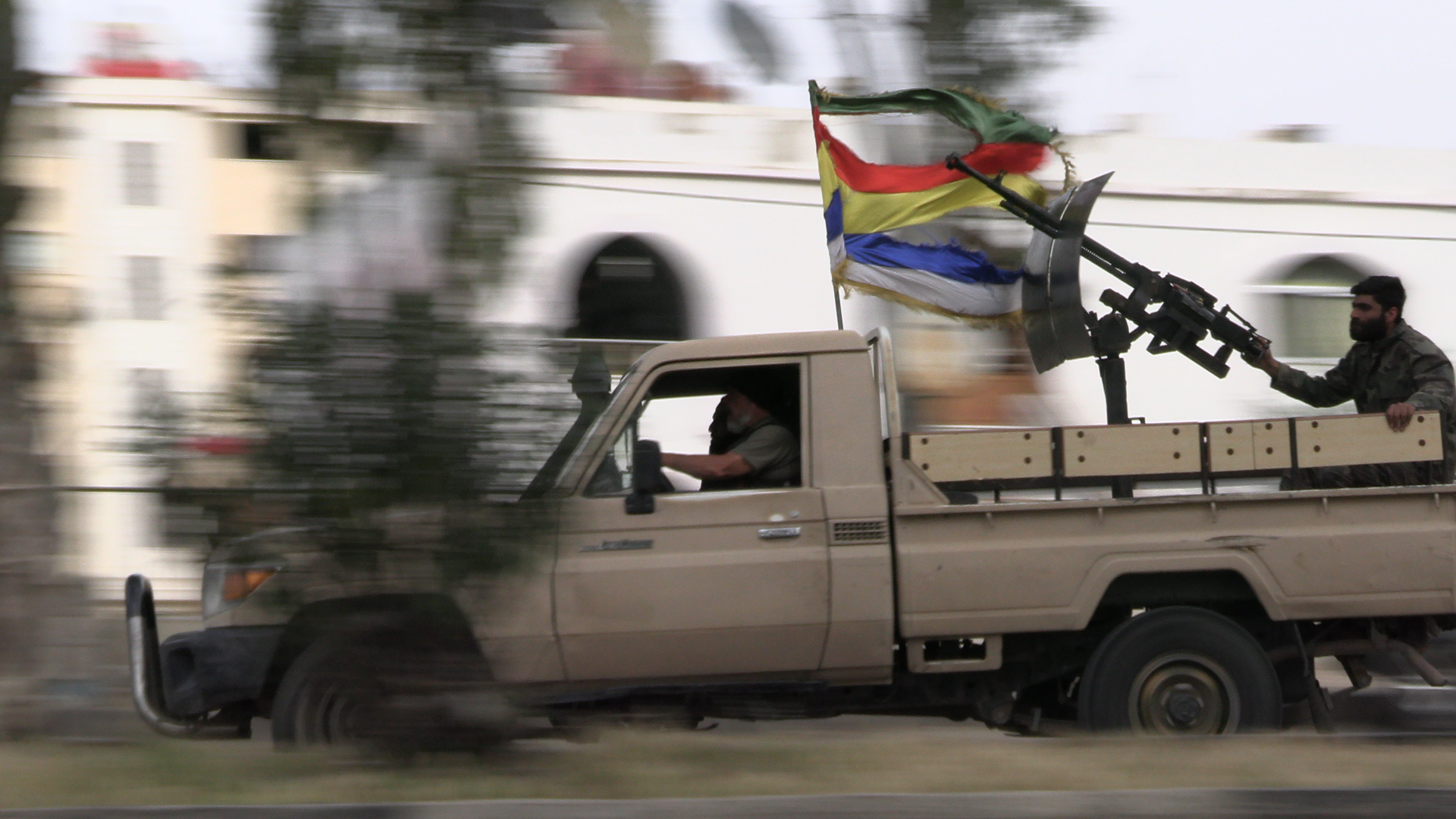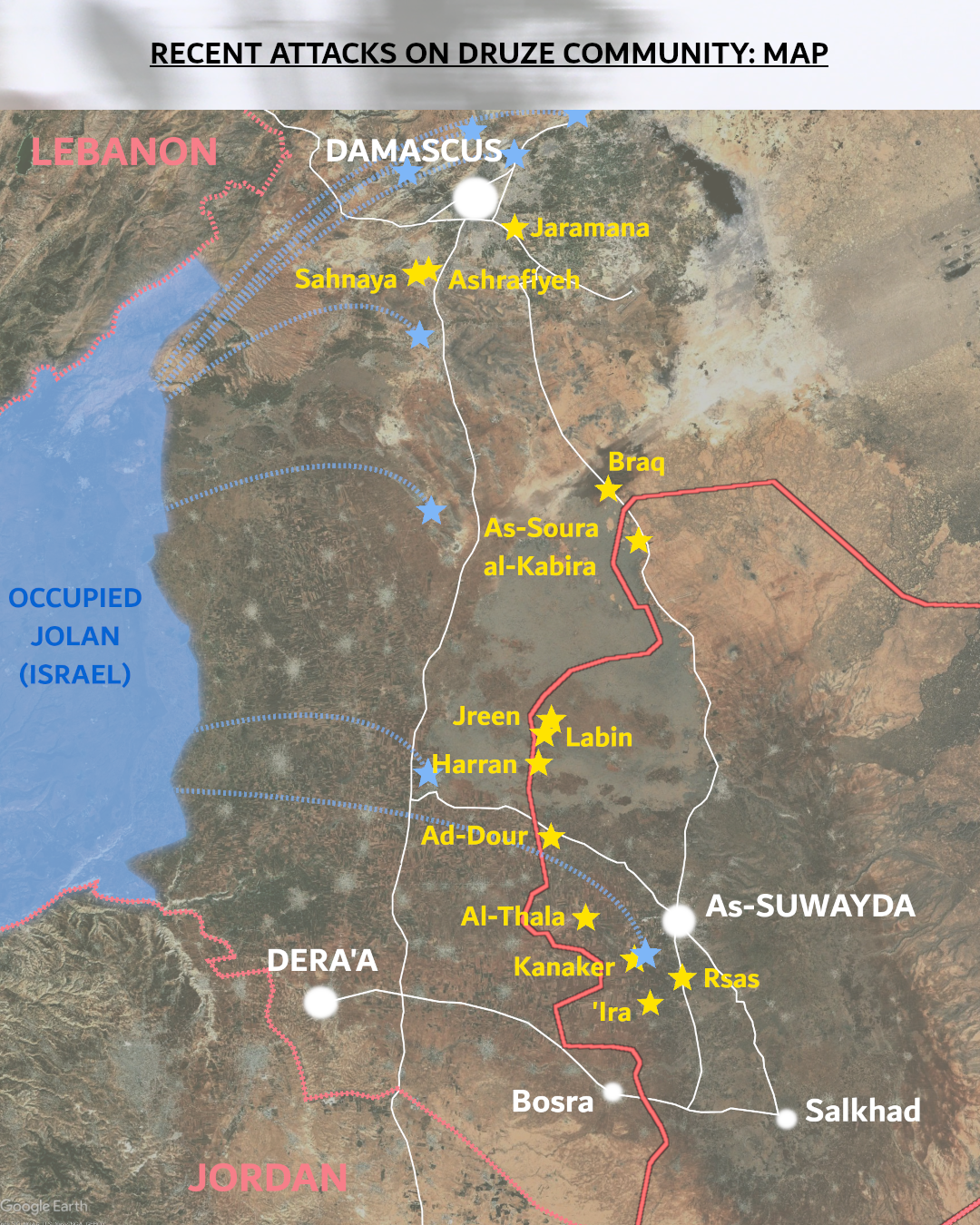
Over the past week, Syria’s Druze community has suffered an unprecedented attack by sectarian and Islamist armed groups, with the passive support of the new government in Damascus.
We are currently in Syria, close to the events. Here is our description and analysis.
APRIL 27
A fake record circulated on social media, in which a non-identified voice is heard insulting the prophet Muhammad, provoking sectarian riots by Islamists in the University of Homs, led by the petrol-engeneering student Abbas Al-Khaswani.
This Islamist agitator was giving a hateful speech targeting several religious communities including the Druze, the Alawi and the Kurds. Following this speech, tens of people chanting sectarian and hateful slogans were demonstrating in the University compound and assaulting non-muslim students.
The old Druze sheikh Marwan Kiwan accused of being the author of the record soon denied this accusation. It is reminded that Muhammad is not only a prophet for sunni muslims, but also for the Druze.
The non-elected authority in Damascus published a weak press release in which it thanked the rioters for their efforts to defend their prophet, instead of holding them accountable for the dangerous unrest they provoked.
Abbas Al-Khaswani is not a student in Islamic studies and was identified as one of the armed perpetrators in the attacks on the Syrian coast two months earlier. He was not arrested and went back the next days to the university where he and his colleagues threatened the lives of other students.
APRIL 29
The authenticity of the record that sparked racist and sectarian riots two days earlier was denied by the Syrian Minister of Interior, but the General Security did not do anything to prevent the unfolding events.
Thus, armed groups of unknown origin attacked the town of Jaramana, targeting its residents and druze local self-defense factions.
The General Security intervened and were allegedly targeted by the local factions, while the difference between the early attackers and the newcoming members of the General Security remains unclear. Locals identified the unknown attackers as tribal factions from the Al-Uqaydat tribe of Deir Ez-Zor.
17 SYRIANS WERE KILLED, most of them from the attackers. All of them are then presented as members of the General Security while the local factions were presented as responsible for the clashes.
It is vital to remember that Jaramana IS NOT a Druze Only neighborhood, but rather, it represents the diversity of the Syrian social fabric, including refugees from Palestine and Iraq.
APRIL 30
Following a similar scenario as in Jaramana, armed islamist groups from Dera’a, Deir Ez Zor and Ghouta attacked the towns of Sahnaya and Ashrafiyeh-Sehnaya, targeting its residents and the Druze local self-defense factions.
45 SYRIANS WERE KILLED, most of them from the Druze community, including 10 field executions of civilians. Among them was the mayor of the city Hussam Warwar with his son Haider. He was seen welcoming the General Security forces hours before his assassination.
It is vital to remember that Sahnaya and Ashrafiyeh-Sehnaya ARE NOT a Druze only neighborhoods.
On the other hand, Druze factions from Suwayda left the governorate to rescue their community under attack in Sahnaya and Ashrafiyeh, but they were ambushed next to Braq on the Damascus road by mixed groups of local tribes, Islamists from Dera’a and Deir Ez Zor, but also elements of the General Security. There is a video showing them clearly opening fire while standing side by side.
42 SYRIANS WERE KILLED, most of them from the Druze factions, the community of Salkhad being particularly impacted, with 11 martyrs from the Quwaat Al-Alya’ and Quwaat Sheikh al-Karami self-defense factions, including their leader Amjad Baali.
MAY 1st
During the night, armed groups of unknown origin attacked the towns of As-Sawara al-Kabira, Al-Thala, Ad-Dour, ‘Ira, Kanaker and Rsas, leading to heavy clashes with local self-defense factions and shelling of civilian houses.
All the Suwayda factions composed of more than 80 000 fighters were put on high alert and spreaded to all the strategic points of the governorate.
In the evening, the General Security surrounded the governorate, allegedly to prevent any further attacks from Dera’a. However, several armed groups attacked the towns of Lebbin, Harran, Ad-Dour and Jreen, where they were met with strong resistance that left most of the attackers dead. The number of casualties is unknown, but the attackers were identified as belonging to the local tribes.
All the Druze community leaders were put under pressure by the central authority in Damascus to agree on the disarmament of the local factions, unfairly accused of being responsible for the unrest. In the night, the Druze leadership issued a statement to inform about the agreement that was met, but it stayed unclear until the next day, with contradictory and fake information being spread.
Israel used the situation to threaten Syria and bombed the presidential palace in Damascus, allegedly to “warn” Syrian authority over the threats to the Druze.
MAY 2 to 4
On May 2nd, an Israeli drone was flying above Suwayda and targeted a farm in Kanaker, killing 4 of its Druze residents. One of them, Issam Azam, who was known to be an active supporter of the protests in Karami square against the Assad regime. In the following night, Israeli planes launched series of strikes on military sites in Dera’a, Damascus and Hama.
On May 3rd, Khaldun Sayah Al-Mhithawi, a Druze lawyer involved in negotiating the release of another lawyer who was kidnapped north of Suwayda, was assassinated in Aqraba, located next to Jaramana. The same day, the 11 martyrs from Salkhad were buried following a ceremony gathering thousands of mourners in their hometown, with the presence of the prince Hassan al-Atrash and Aqel Sheikh Hammoud al-Hennawi.
On May 4th, the Druze leadership issued a five-point statement providing for the activation of the police and general security in Suwayda governorate, on a condition that its members are all from the region, as well as securing the road to Damascus plus a ceasefire in all areas affected by the clashes of recent days.
Laith Al-Balous, the leader of the “Madhafet al-Karami” faction, who was actively involved in negotiating the entrance of the General Security into Suwayda governorate, was pushed out of his town of Mazra’a by its residents after he provided access to several General Security vehicles.
MAY 5th
At day, clashes between local tribes and Druze factions were still ongoing in the vicinity of al-Thala and Harran in Suwayda.
After the withdrawal of the General Security from the town of As-Sawara al-Kabiri, the police of Suwayda entered the town with the governor Mustafa Bakkur and found several houses burnt and looted, as well as the Druze shrine of the village.
It is notable that the only town where homes were looted and vandalized in Suwayda is also the only one where General Security forces were deployed.
At the same time, rumors circulated that Druze factions were threatening mosques, when in fact they had been deployed to protect Muslim religious sites. Several imams from the region and representatives of local Bedouin tribes denied these rumors of sectarian threats by the Druze towards Muslims, reaffirming peaceful coexistence within the governorate and the need to tackle “fake news” and sectarian incitement on social media.
BULLET POINTS
– The recording that sparked the sectarian outrage was fake, and the person responsible for the racist riots at the University of Homs has not been arrested;
– The only offenders are armed groups with Salafist affiliations, but not at any moment they were named by the authorities, while their members who were killed in the clashes were not officially identified as the main offenders;
– The situation was either provoked or exploited by the central authority in Damascus to put pressure on the Druze community’s self-defense factions and justify their disarmament;
– Community leaders with authority over the tribes suspected of being behind the armed attacks have been rewarded with the highest positions of power in the new state apparatus;
– The authorities and the media have fostered or allowed a wave of sectarian hatred on social media, falsely accusing the victims of being responsible for the clashes plus of attacking General Security forces;
– The authorities have surrounded the Suwayda region, generating fear among its residents, while being unable to guarantee and restore the safety of users on the 110 road to Damascus;
– The majority of the population as well as the main factions in the Suwayda region – those that existed before the fall of the Assad regime and were legitimate among the revolutionary movement – reject Israel’s intervention and insist on unity with all other Syrians;
OUTCOMES
After a week of violence, the Damascus government continues to deny the existence and the identity of the armed groups responsible for the attacks on more than 10 Syrian towns and their inhabitants. All this, despite numerous sources indicating the involvement of some Bedouin tribes, as well as a group called “Burkan al-Furat” which is even bragging about the assault on its Telegram group.
One of the worrying outcomes of these three days is the appointment by Al-Sharaa of three members of the very influent Al-Uqaydat confederation of Bedouin tribes from Al-Shuhayl (Deir Ez-Zor), to positions of responsibility: Hussein al-Salama as head of intelligence, replacing Anas Khattab, Amer Names al-‘Ali as Chairman of the Central Monitoring and Inspection Authority (fight against corruption) and sheikh Rami Shahir al-Saleh al-Dosh as head of the Supreme Council of Tribes and Clans.
We can legitimately wonder whether the authority in Damascus has a free hand, or whether it is under pressure from the traditional power structures that have been destroying the lives of Syrians for half a century or more. The key question is: who benefits from the disarmament of the Druze community’s self-defense factions?
In Jaramana, the agreements included the progressive disarmament of the local factions, who have begun to hand over their heavy weapons. On the other hand, the armed groups that attacked them are not required to surrender their weapons…

